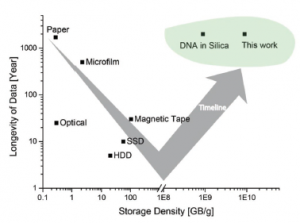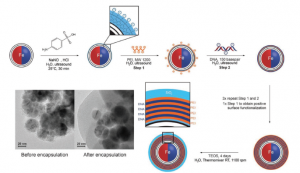Long term storage of data is a problem that humans have been grappling with for centuries. The advent of computers enabled orders of magnitude more data to be stored in a much smaller space than ever before (see below), but this revolution was not without its challenges.

Characteristics of information storage techniques.
The data stored by computers tends to reside on magnetic tape, a medium that has a lifespan measured in decades. While paper cannot rival the information density of magnetic tape, it does last quite a bit longer.
At the present time, information stored on magnetic tape must be rewritten every 20–30 years to ensure its accuracy.
Nature chooses a denser, more resilient medium for information storage; DNA.
Humans have been aping this technique synthetically since the 1990s. The processing of this data is slow, preventing uptake for general computing, but if stored correctly, information coded in DNA could be preserved for hundreds of thousands of years.
Synthetic DNA data storage still does not rival the information density of the natural variety. However, the state-of-the-art in this area is constantly evolving.
Recent work published by an international team pushes the limits of this technology even further.
The team used an approach termed ‘Layer-by-Layer’ design. This strategy makes use of the negative charge of the DNA backbone; the DNA is iteratively laid down over spherical layers of a positively charged polymer. These layers are supported by a magnetic core that helps speed up the fabrication process.
Finally, the finished nano-particle is coated with a protective silica layer as shown in the fabrication technique schematic.

Fabrication technique.
To establish the efficacy of the new architecture, both the information density and longevity of the stored DNA were tested.
It was found that the information density of this system is ten times greater than the previous state-of-the-art. Accelerated aging experiments showed that at room temperature the storage half-life is in the range of 20–90 years.
It is hoped that this type of technology could be used to safely store large amounts of valuable data for posterity.

















